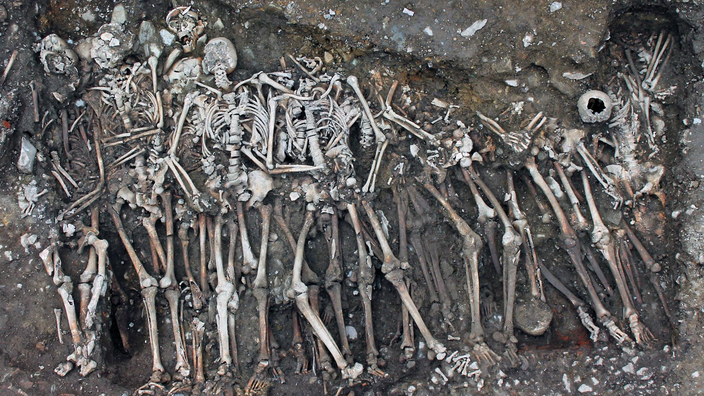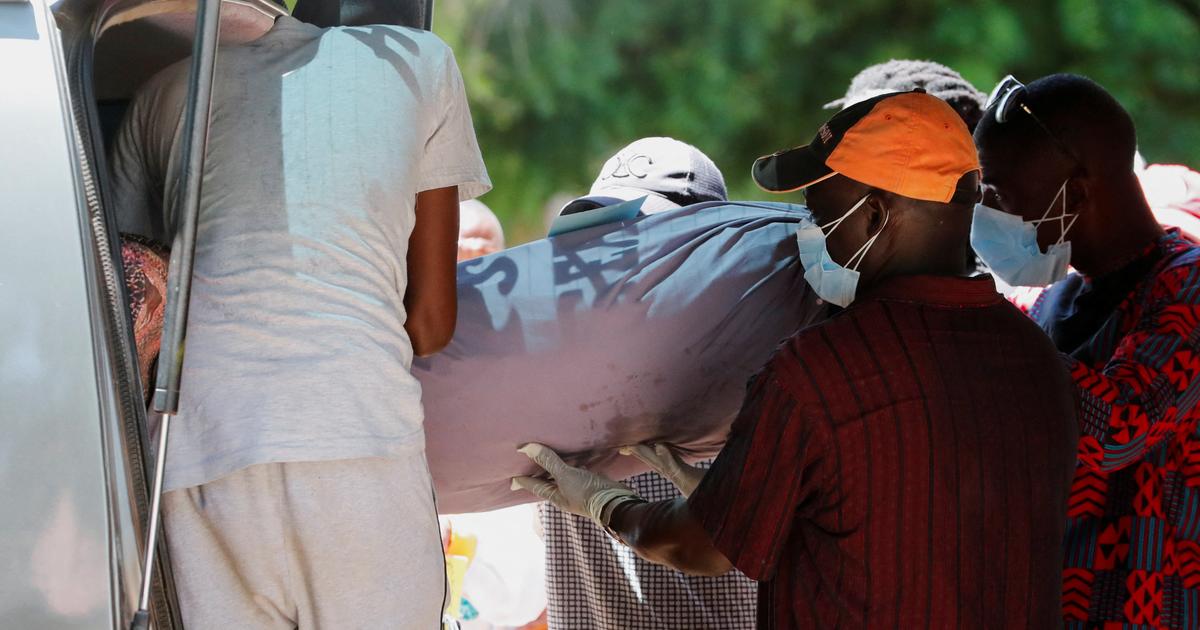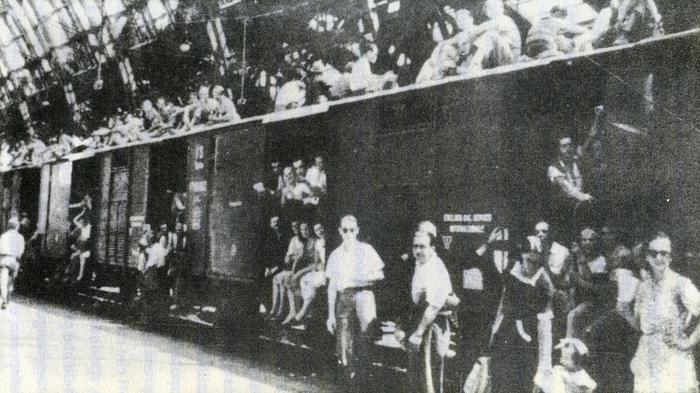They are among the last soldiers to have fallen during the time of the independent Duchy of Brittany.
Spread over two mass graves dug outside the Jacobins convent, 32 remains were unearthed during the excavation carried out several years ago by Inrap teams.
Quite complex to grasp, like every mass grave, the content of this archaeological ensemble has been the subject of a vast international research program, the conclusions of which, published this week in two articles in the scientific journal
PLOS ONE
, are without appeal: the deceased were all soldiers killed during the siege of Rennes, in 1491, the last chapter of the war in Brittany.
Better yet: using a new approach to the study of isotopes, the researchers were able to determine part of the experiences of the dead and identify their camp among the two enemy armies.
Read also: A thousand graves discovered in Rennes
Located in the immediate outskirts of Rennes, just north of the city walls, the Jacobins convent was the subject of a large preventive excavation campaign in 2011-2013, upstream of the redevelopment of the site into a convention center. Of the thousand burials associated with the convent, two mass graves were discovered at the very end of the work. Collective burials, dug and filled in a short time during a single episode, they are typical of
“disaster burials”
, made after a tragedy.
"We weren't looking for the 'more' burial, but these multiple burials are the subject of the attention of anthropologists, because they necessarily sign an event, an epidemic, a war"
, tells in an interview with Inrap the archaeo-anthropologist Rozenn Colleter, who took part in the work just published.
Curiously, despite their proximity and their contemporaneity, the two pits were unevenly occupied: one thus contained 28 remains, against only 4 in the other.
What had happened?
And when ?
Read also: The place name war is raging in Brittany
War victims
The juxtaposition of human remains at the headquarters of Rennes was undoubtedly the most understood stage of the post-excavation work carried out on these two burials. Chronologically, the pits dated from the first phase of the convent, circumscribed to a period going from its foundation, in 1368, until the 16th century; a dating barely more refined by carbon 14 analyzes of the bones which indicated to archaeologists a fairly wide range from the middle of the 15th to the end of the 16th century. The 32 deceased found were all adult males, rather tall and young, even very young since three adolescents aged about 15-20 years at the time of their death are also part of the lot. The cause of their collective burial was not a lightning epidemic but a violent warlike event, like theattest the traces, preserved on the bones, of wounds and lesions carried out with knives, by sharp and pointed blows. The noted absence of the slightest trace of bullets or even artillery helps, finally, to rule out the hypothesis of graves linked to the Wars of religion, leaving only the War in Brittany (1484-1491) among the events probably in the origin of these two mass graves.origin of these two mass graves.origin of these two mass graves.
Careful excavation of the tomb attributed to the royal camp during the siege of Rennes in 1491. Rozenn Colleter / Inrap
It remained to identify the affiliation or even the origin of these thirty unfortunate people, since no material vestige made it possible to do so.
To achieve this, scientists have employed and refined a geolocation technique by isotopic analysis of strontium, sulfur and oxygen taken from each individual buried, inside bones and teeth.
A method which, unlike DNA, provides information on a part of the experiences of the dead.
"The siege of Rennes was a good textbook case because it could involve soldiers from several European countries"
, comments Klervia Jaouen, researcher and biochemist at CNRS.
Read also: When hair analysis helps to elucidate a crime
Already used for several years,
"the basic principle of isotopic geolocation is to build maps that predict how these isotopes vary on the surface,"
Clément Bataille from the University of Ottawa explained to Inrap. directed this part of the research.
"Once we have these maps we can compare the tissue values of an individual of unknown origin with them to try to find where he came from
.
"
"The model to determine the geographical origin of strontium was developed by Clément Bataille, first author of one of the two articles, and it had never been applied to archaeological material"
, also specifies Klervia Jaouen.
"The main innovation of our study is to have added the isotope of sulfur"
.
Predictive map of sulfur isotope distribution across Europe.
PLOS ONE CC-BY 4.0 International license
Tracing the lived experience of the dead
Armed with these innovative isotopic tools, the researchers managed to identify the restricted geographical areas in which the individuals buried during their youth and the last years of their life evolved, which, for the youngest remains discovered in Rennes, made it possible to reconstruct pretty much their entire journey. The 28 corpses identified in the larger of the two pits thus belonged to the soldiers of the French camp. Of very diverse origins, these troops of the royal army came, according to isotopic analyzes, from the whole country, from the Alps to the north of the Paris Basin, via Poitou and the Rhone valley; with a few individuals who were additionally from Spain, England and the Holy Roman Empire. Theisotopic analysis carried out on these corpses also revealed an unequal diet, attested by
"A heterogeneous consumption of animal proteins"
, which would betray a variety of social conditions in the ranks.
So many clues that historians can seize upon, for example for the study of recruitment strategies in France at the end of the Middle Ages, or for the analysis of the daily life of soldiers.
Read also: The 4,000-year-old slab of Saint-Bélec is said to be the oldest map in Europe
The four deceased buried in the nearby pit were almost certainly from the Breton camp.
“Of the four individuals, three are compatible with local isotopic ranges. The fourth did not grow up in Brittany, ”
says Rozenn Colleter. All four were, however, more or less related, as revealed by genetic analyzes which revealed a common genetic group. This was also shared by Louise de Quengo, a 17th century Breton noble lady whose remains had also been buried in the Jacobins convent. It was therefore, perhaps, four Breton nobles who fell during the siege, one of whom had spent most of his life outside the peninsula before returning there and losing his life.
The quantity and the precision of the details which it is possible today to extract from archaeological remains far exceed what could be expected a few decades ago.
“The use of three isotopes allows us to narrow down more precisely the probabilities of provenance. It is a real scientific advance for the knowledge of the mobility of human beings ”
, says Clément Bataille. The opening up of this new field of archaeological research opens up promising perspectives in particular in the study of the history of migration. In Rennes, its use will thus have made it possible to show the geographical diversity of the troops engaged in the War in Brittany, and to underline once again, the essential complementarity of all the techniques and disciplines of our time to better understand the material of our time. common past.















